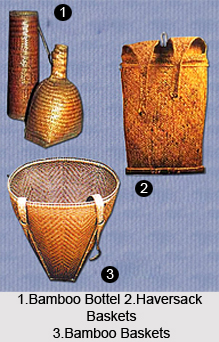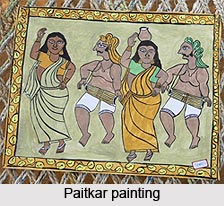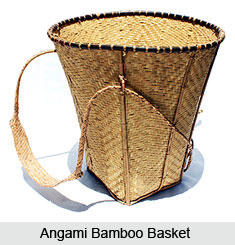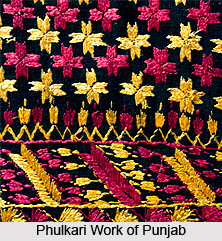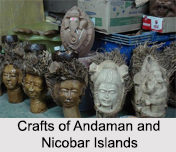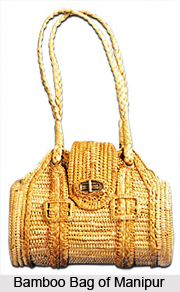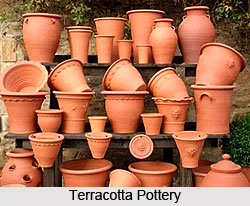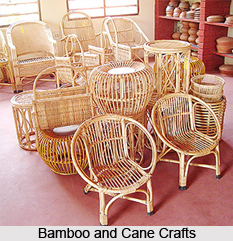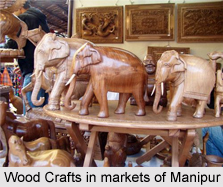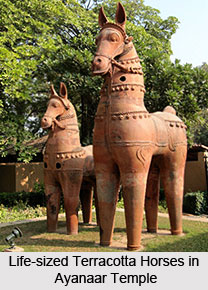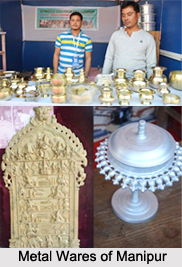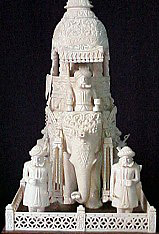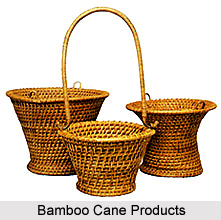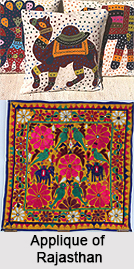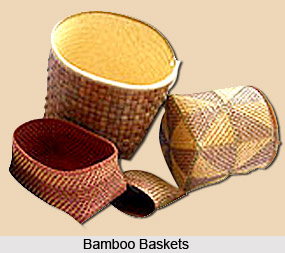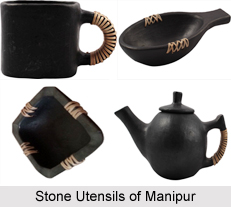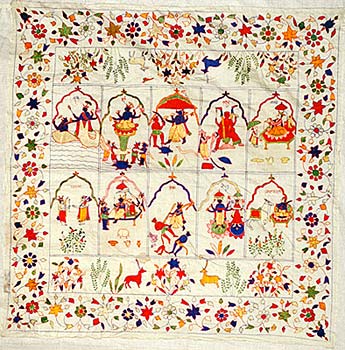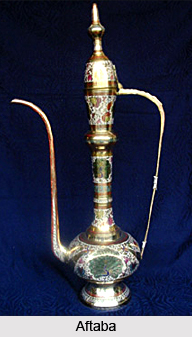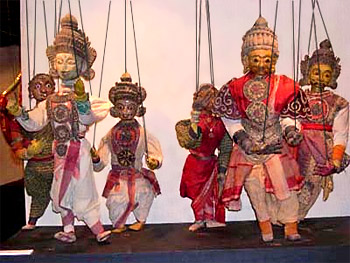About Manipur Tribes' Baskets
 Baskets, of different shapes and structures, are prominent products used by the tribes of Manipur for varied purposes. An interesting custom among the tribal belts of Manipur is the practice of presenting a close weave conical basket as part of the dowry, when a daughter in the family gets married. It is a firm belief amongst the tribal folks that if a daughter is born, then the family must make a present of such baskets as dowry at the time of the girl"s marriage. Right at the time of birth of the girl child, the elders of the family prepare such a basket and store it upon the Lup, where it is exposed to steam and smoke for conditioning. Thus, the practice is still in vogue despite various social changes. If the elders in the family cannot make one, then they purchase it from the village craftsmen who make such baskets on demand. It becomes a natural duty for the elders of the family to weave or to purchase such number of baskets as corresponding to the number of unmarried girls in the family, and keep them in store for use later. The practice of keeping a conical basket stored for use at the time of a girl`s marriage is thus considered an integral aspect of the tribal custom, and, in a way, is more or less an evidence of the living tradition. Apart from this, the elders make small conical baskets for use by the kids in the family.
Baskets, of different shapes and structures, are prominent products used by the tribes of Manipur for varied purposes. An interesting custom among the tribal belts of Manipur is the practice of presenting a close weave conical basket as part of the dowry, when a daughter in the family gets married. It is a firm belief amongst the tribal folks that if a daughter is born, then the family must make a present of such baskets as dowry at the time of the girl"s marriage. Right at the time of birth of the girl child, the elders of the family prepare such a basket and store it upon the Lup, where it is exposed to steam and smoke for conditioning. Thus, the practice is still in vogue despite various social changes. If the elders in the family cannot make one, then they purchase it from the village craftsmen who make such baskets on demand. It becomes a natural duty for the elders of the family to weave or to purchase such number of baskets as corresponding to the number of unmarried girls in the family, and keep them in store for use later. The practice of keeping a conical basket stored for use at the time of a girl`s marriage is thus considered an integral aspect of the tribal custom, and, in a way, is more or less an evidence of the living tradition. Apart from this, the elders make small conical baskets for use by the kids in the family.
 Conical baskets are usually carried about by placing the straps, called Namlee, that are attached to the baskets, upon the head with the basket resting on the back. The normal posture of the person carrying such baskets is inclined at 45 degrees. To ease the task of carrying heavily laden baskets, the men folk use a shoulder-length wooden appliance called Lengkot, fixed to the Namlee. The Lengkot is placed horizontally on the nape of the neck, but is mainly borne by the shoulders. The womenfolk of the Moyon, the Monsang and the Lamgong tribes use cane Lengkots instead of wooden ones. Resembling the wooden Lengkots, the cane Lengkots feature a slightly curved shoulder-length stiff cane of big size, fixed to the Namlee. The Namlee on conical baskets are of two types: those fixed permanently on the baskets and those which are removable and replaceable with new ones. Some tribes like the Kom, the Vaiphei and the Haokip keep the conical baskets and the Namlee stored separately when not in use. The Namlee is fixed onto the basket only when needed for its use. To lesson the pressure of baskets on the back, the womenfolk of the Maram tribe use mats (54 cms x 26 cms) attached to the Namlee, placed in between the basket and the back. These mats are made up of dried plants called Shalem, found abundantly on the banks of Barak River. The Mao, the Maram and the Paomai tribes hold a great importance to Namlee and decorate it with exquisite designs and patterns. Corresponding to the differences in the structure of the conical baskets from one particular tribe to the other, the base of the conical baskets of each tribe differs accordingly. The difference ranges from the use of bamboo or dried vine, either of Uri or Chingthrao (Bauhinia vahlii) for the base to the use of bark of the Heirit plant (Ficus cunia) for the same. The Maram womenfolk employ a device, a thorn-like projection called Shou, by means of which the items kept inside the baskets are prevented from spilling out when the baskets get accidentally dropped on the ground or if they happen to overturn. The Shou are left projecting like thorns or hooks on the inner surface of the baskets in their weaving.
Conical baskets are usually carried about by placing the straps, called Namlee, that are attached to the baskets, upon the head with the basket resting on the back. The normal posture of the person carrying such baskets is inclined at 45 degrees. To ease the task of carrying heavily laden baskets, the men folk use a shoulder-length wooden appliance called Lengkot, fixed to the Namlee. The Lengkot is placed horizontally on the nape of the neck, but is mainly borne by the shoulders. The womenfolk of the Moyon, the Monsang and the Lamgong tribes use cane Lengkots instead of wooden ones. Resembling the wooden Lengkots, the cane Lengkots feature a slightly curved shoulder-length stiff cane of big size, fixed to the Namlee. The Namlee on conical baskets are of two types: those fixed permanently on the baskets and those which are removable and replaceable with new ones. Some tribes like the Kom, the Vaiphei and the Haokip keep the conical baskets and the Namlee stored separately when not in use. The Namlee is fixed onto the basket only when needed for its use. To lesson the pressure of baskets on the back, the womenfolk of the Maram tribe use mats (54 cms x 26 cms) attached to the Namlee, placed in between the basket and the back. These mats are made up of dried plants called Shalem, found abundantly on the banks of Barak River. The Mao, the Maram and the Paomai tribes hold a great importance to Namlee and decorate it with exquisite designs and patterns. Corresponding to the differences in the structure of the conical baskets from one particular tribe to the other, the base of the conical baskets of each tribe differs accordingly. The difference ranges from the use of bamboo or dried vine, either of Uri or Chingthrao (Bauhinia vahlii) for the base to the use of bark of the Heirit plant (Ficus cunia) for the same. The Maram womenfolk employ a device, a thorn-like projection called Shou, by means of which the items kept inside the baskets are prevented from spilling out when the baskets get accidentally dropped on the ground or if they happen to overturn. The Shou are left projecting like thorns or hooks on the inner surface of the baskets in their weaving.
The carrying baskets with straps are usually hung like bags on the left or the right shoulder. Some carrying baskets with straps are carried in the same fashion as the conical baskets, i.e., hung on the back with the straps placed upon the head. The baskets normally hung on the shoulders are of an elongated, compressed type. The men folk of Andro village and the tribal men folk use such type of baskets in hunting, jungle trekking, field work etc. Andro men folk use a fishing basket called Sungtu, the height of which is 36 centimetres with the diameter of the mouth being 11 centimetres.
Womenfolk of Maram and Paomai tribes use baskets with straps, having circular mouths and square base for carrying things when going to paddy fields and markets. The baskets are short in stature. The basket used by the Paomais for fishing purpose is called Be, with height 13 centimetres and the mouth"s diameter 16 centimetres. Women of the Chiru Tribe use a small carrying basket with strap called Inbow, while going to work in the paddy fields. These baskets dangle from the waist. The two ends of the straps are fixed to the basket forming a sort of round belt. The person then fits himself in the belt, pulling it from the feet up to the waist where it is adjusted and tied as desired. These Inbows are basically used for keeping smoking pipes and tobacco. The Chiru tribe use a basket known as Pai for fishing, with the height of 35 centimetres and diameter of the mouth 20 centimetres.
The Maram Tribe uses a container basket called Rashakok, which is finely woven in the open weave type with thin bamboo splits. In December, they celebrate community festival in which banana leaves are spread out on these Rashakok baskets and the men folk eat rice served on the banana leaves. Each household has a minimum of 3 to 4 Rashakoks, as per the number of family members. It is an indispensable tradition for the Maram tribe to keep Rashakoks, if and when a new home is established. The Maram tribe also uses two types of fishing baskets, Kaijara, with 46 centimetres length and 85 centimetres circumference of the mouth, and Khoshii, with 21 centimetres height and 14 centimetres mouth diameter.
The Maring Tribe use a cane and bamboo basket which is generally used as a common dining table for the family, about 7 centimetres high. They use a fishing basket called Tik with a length of 25 centimetres and 11 centimetres diameter. Hulluk is a type of container vessel used by the Tangkhul Nagas of Manipur. Umbong is a loosely woven basket used by the Vaiphei tribe to carry a gourd containing rice beer. The Haokip tribe on the other hand uses a thickly woven basket made from cane for drinking rice beer. 
The Moyon and the Monsang tribes use a particular container basket called Irang on which steamed rice is poured out, and unwanted ingredients like rice chaffs, weed seeds, tiny pebbles etc. are picked out. The form of the Irang is concave and it has a circular base which makes it possible to keep the basket firm without the least fear of tilting it. Irangs have two forms of weave, an outer weave and a surface weave. The Monsang tribe also uses a container basket called Baruk, which is sturdy, useful and decorative, in addition to a fishing basket called Butu, 25 centimetres high and 11 centimetres diameter.
The Yangkok baskets used in Manipur are generally made by the Koibu-Maring, the Ngarum-Maring and the Purum-Chothe tribes. The Tarao tribe also makes such baskets. There is an apparent difference between the Yangkoks made by the Marings from those of the Chothes, being the former has a drooping bottom whereas the later has a firm one. At the time of using the Yangkok, some people apply cow dung onto the bottom of the basket so that it becomes firm when it dries. It ensures a more efficient handling while winnowing rice chaffs. If it so happens that the dried cow dung fall off piece by piece after some time, the usual practice is to apply fresh cow dung and then dry it in the sun.
Rectangular baskets are used by the tribes of south Manipur for drying grains in the sun. In construction, the corners of these baskets are slightly elevated in a drooping fashion. Barring this, the rest of the rim is plain and when not in use, the basket can be rolled up and stored away.
Storage Baskets used by Tribes of Manipur
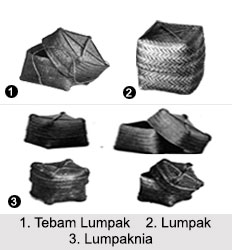 Baskets used for the purpose of storage are prevalent in different designs, shapes and sizes amongst the tribal belts residing in the hills of Manipur. These baskets are used for the storage of clothes, valuables, yarn meant for making cloth, grain, dry fish, chilli and meat.
Baskets used for the purpose of storage are prevalent in different designs, shapes and sizes amongst the tribal belts residing in the hills of Manipur. These baskets are used for the storage of clothes, valuables, yarn meant for making cloth, grain, dry fish, chilli and meat.
The Tangkhul Nagas of Manipur have a number of storage baskets in their tradition. Tebam Lumpak is a medium-sized basket, generally 17 centimetres high with a square cross-section of 22 centimetres of sides, and is used by the Tangkhul Nagas for storing thread and yarn. Lumpaknia is another small bamboo basket of the Tangkhul Nagas, used for storing valuables. It is a lidded basket, generally about 7 centimetres high and a square cross-section slightly tapering towards the mouth. The mouth measures 11 centimetres X 11 centimetres. There is also a slightly higher Lumpaknia, with 9.5 centimetres height including the lid with square cross-section of 10 centimetres of sides. Lumpak is a basket also used by the Tangkhul Nagas for the storage of valuables. It measures about 11 centimetres high and size of the mouth being 9 centimetres by 9 centimetres. Kamu is a storage basket used by the Tangkhul Nagas for storing dry fish and meat. It is 19 centimetres high with a square base that is strengthened by cane sticks affixed diagonally. The central cross section is round and the top is narrower with a detachable lid.
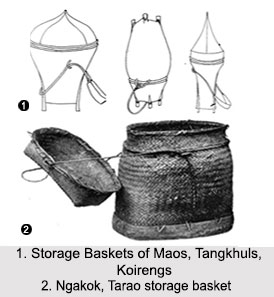 The Mao (constituting both Memis and Paomatas), the Maram, the Paomai and the Chakasang tribes residing in the districts of Senapati and Ukhrul, use a grain storage basket with lid. It has a narrow mouth with an inflated body. The size ranges from a waist high basket to a head high basket, and even taller and bigger baskets. This particular type of basket has a double weave: an inner weave and an outer weave. The first layer is the construction with bamboo as the basic form, over and above which, another variety of stiff bamboo is woven as the second layer or the outer weave. After completion of the basket, the inner surface is appropriately lined with cow dung and strengthened. The basket is then put to use.
The Mao (constituting both Memis and Paomatas), the Maram, the Paomai and the Chakasang tribes residing in the districts of Senapati and Ukhrul, use a grain storage basket with lid. It has a narrow mouth with an inflated body. The size ranges from a waist high basket to a head high basket, and even taller and bigger baskets. This particular type of basket has a double weave: an inner weave and an outer weave. The first layer is the construction with bamboo as the basic form, over and above which, another variety of stiff bamboo is woven as the second layer or the outer weave. After completion of the basket, the inner surface is appropriately lined with cow dung and strengthened. The basket is then put to use.
The Tarao tribes of Manipur also use different makes of baskets for the purpose of storage. Adungshei is a basket used by the Tarao tribe for storage of yarn. Its bottom and lid are strengthened with diagonal pieces of cane and bamboo sticks, while the basket itself is made in a single weave. These baskets are usually 13 centimetres high with lid, 23 centimetres long and 15 centimetres wide. Ngakok is another single weave basket used by the Tarao tribe, for storage of dry fish. The bottom is strengthened with additional strips of bamboo woven outside, and the lid is separable but attached with the basket by a handle with loop. Ngakoks are usually 37 centimetres high, 25 centimetres long and 16 centimetres wide with an oval cross-section, a narrow mouth and bulges towards the bottom.
The designs of baskets used for storing clothes, like the Tabu, vary considerably from tribe to tribe. The Vaiphei tribe refer to Tabu as Laipi, which has an almost identical shape but is slightly smaller in size and do not have a knob on the lid. The Mao design of the Tabu encompasses a pointed lid, bulging at the mouth and narrower towards the bottom. The Tabus of the Tangkhuls have a lid bigger than the basket itself and have stands on both the lid and the basket, such that it can be kept in any manner as one feels. The Tabu design of the Koirengs has a pointed lid, bulging at the mouth and a narrower bottom.
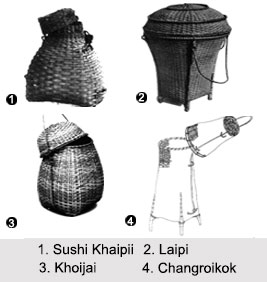 The Paomai Nagas too have their own specialised designs of storage baskets. Sushi Khaipii is a 30 centimetre high single weave basket used by them for storing chilli. It has a narrow mouth and bulges below. Bou is a type of basket used by the Paomai Nagas for grain storage. It is a sturdy basket woven with thick bamboo or cane strips, narrow at the mouth and bulging at the centre, with a conical lid. It extends usually 1.5 metres high. Khoijai is a type of storage basket used by the Rongmei Nagas, for storing dry fish and meat. It also has a narrow mouth, bulges at the middle, stretches 32 centimetres high with lid and a mouth diameter of 12 centimetres. It is a single weave basket and the lid is hemispherical. Changroikok is a type of basket used by the Chiru tribe for storing dry fish and meat. It has a conical lid, flattened at the top. The basket is sturdy, though single woven since it is woven with thicker bamboo strips. The mouth is narrow and circular, cylindrical up till a certain point, thereafter bulging and being widest at the bottom which is square-shaped and supported by stands at all four corners. They are usually 60 centimetres high, with a mouth diameter of 16 centimetres. The Loi people from the Andro village use a basket called Thop, for storing dry fish, chilli etc. It is 38 centimetres high with lid and a mouth diameter of 23 centimetres. A single weave basket, the Thop is slightly narrower at the mouth where the cross section is circular, and bulges slightly till it acquires the square shape at the bottom.
The Paomai Nagas too have their own specialised designs of storage baskets. Sushi Khaipii is a 30 centimetre high single weave basket used by them for storing chilli. It has a narrow mouth and bulges below. Bou is a type of basket used by the Paomai Nagas for grain storage. It is a sturdy basket woven with thick bamboo or cane strips, narrow at the mouth and bulging at the centre, with a conical lid. It extends usually 1.5 metres high. Khoijai is a type of storage basket used by the Rongmei Nagas, for storing dry fish and meat. It also has a narrow mouth, bulges at the middle, stretches 32 centimetres high with lid and a mouth diameter of 12 centimetres. It is a single weave basket and the lid is hemispherical. Changroikok is a type of basket used by the Chiru tribe for storing dry fish and meat. It has a conical lid, flattened at the top. The basket is sturdy, though single woven since it is woven with thicker bamboo strips. The mouth is narrow and circular, cylindrical up till a certain point, thereafter bulging and being widest at the bottom which is square-shaped and supported by stands at all four corners. They are usually 60 centimetres high, with a mouth diameter of 16 centimetres. The Loi people from the Andro village use a basket called Thop, for storing dry fish, chilli etc. It is 38 centimetres high with lid and a mouth diameter of 23 centimetres. A single weave basket, the Thop is slightly narrower at the mouth where the cross section is circular, and bulges slightly till it acquires the square shape at the bottom.
Fishing Baskets used by Tribes of Manipur
 The tribes inhabiting the hills of Manipur make and use baskets of different shapes and sizes, for the purpose of fishing. The Puram Chothe and the Tarao tribes make and use Long baskets like the Meithei women of the valley, in abundance. The technique of making Long baskets by the tribal belts is interesting. Firstly, the body of the basket is woven with bamboo splits and is more or less a flat structure. Then it is placed over an upright wooden block which has an oval shaped tip. This wooden block is called Ram by the Puram Chothe tribe and it has a height of 60 centimetres and a diameter of 35 centimetres. A circular loop made of bamboo splits is then forced down the Ram from the top, thus pulling down the brim of the flat bamboo structure atop to fit into the circular loop. After getting the right shape, i.e., the bowl shape of the basket, the brim of the bamboo structure is tied firmly to the loop. The basket is then ready to use. This technique of making the Long basket differs somewhat from that employed by the Meitheis. The pattern of weave employed also differs from that of the Meitheis.
The tribes inhabiting the hills of Manipur make and use baskets of different shapes and sizes, for the purpose of fishing. The Puram Chothe and the Tarao tribes make and use Long baskets like the Meithei women of the valley, in abundance. The technique of making Long baskets by the tribal belts is interesting. Firstly, the body of the basket is woven with bamboo splits and is more or less a flat structure. Then it is placed over an upright wooden block which has an oval shaped tip. This wooden block is called Ram by the Puram Chothe tribe and it has a height of 60 centimetres and a diameter of 35 centimetres. A circular loop made of bamboo splits is then forced down the Ram from the top, thus pulling down the brim of the flat bamboo structure atop to fit into the circular loop. After getting the right shape, i.e., the bowl shape of the basket, the brim of the bamboo structure is tied firmly to the loop. The basket is then ready to use. This technique of making the Long basket differs somewhat from that employed by the Meitheis. The pattern of weave employed also differs from that of the Meitheis.
Tik is a fishing basket made and used by the Maring tribe, measuring 25 centimetres long with a narrow circular mouth and a square body, more or less the shape of a glass bottle. It is a single weave basket. Butu is a bamboo fishing basket used by the Monsang tribe. It has a narrow neck, slightly broader mouth, bulges at the centre and a square bottom supported with stands at all four corners. Its lid is conical, be it a bamboo basket used by the Paomai tribe for fishing. It has a narrower neck, bulging body and slightly broader mouth and is a single weave basket.
The use of traps or Lu for catching fish in lakes, creeks, streams, marshes etc. is an age old practice. In fact, fishing net itself is a type of trap. In the hills, only one particular type of Lu, called Soralu, is used. Sometimes, people living in the hill slopes but near the foothills, use a certain type of Lu, called Kabo-Lu, imitating a similar use by the people in the valley. The size of a particular Lu is determined by the size of the particular type of fish to be caught, and the depth of the water where the Lu is going to be laid. Hence, Lus are made and used as per the specific conditions. One very interesting thing is the forgone practice of using Nganaplu by the villagers of Fayang. Observing that a certain type of small bird called Urit was as tasty as the Nganap fish, these people started referring to the Urit as Nganap and the Lu used for catching these small birds came to be termed as Nganaplu. The villagers of Tentha use a Lu called Lulu for catching Ngaprum, an eel like fish, in deep waters. The Lulus are taken on canoes, and laid in the deep waters with the aid of long bamboo poles, to which these Lus are firmly bound.
Almost all the fishing traps have sharp, pointed projections, like the Shous found inside the fishing baskets. The place of fixing the Shou varies according to different traps. These Shous prevent the caught fish from escaping once captured in the Lu. In case of fishing baskets, the Lu, the lid or any other material used for covering the open end is removed first and then the caught fish are poured out. The Tangkhuls of Hundung village use a bamboo tube having a lid and a strap, to contain the caught fish. The apparatus is known as Khoishum.
The binding weaves, as observed in these Lus, differ considerably from one particular type of Lu to another. Different types of binding weaves are used for the varied Lus. The people who make and sell the Lu called Taothum, and those who make such traps for their own use, keep the Lu and the Shou separately after making them. It is only at the time of actual use that the Shou is inserted inside the Lu. For the trap makers of Manipur, it"s a taboo for unmarried youth to drill holes for the particular type of Lu known as Saralu. The job is done only by married men. The Lus are mostly made by the men folk. However, the Lu known as Taothum is sometimes made in great numbers by the women folk. Besides, every individual makes a Lu at home, assisted in the work by his/her friends and relatives. This form of collective work is termed as Khulang, whereby everybody helps one another in making the traps. The Taothum is very much lighter in weight than the other Lus. When laying the traps in the Loktak Lake of Manipur, the basic technique applied is to float the Lu on its belly on the surface of the lake, with the Shou on the upper side so that the fish coming in along with the waves can easily enter into the trap through the gaps in the belly of the Lu. The Shou then naturally prevents the fish from escaping.
